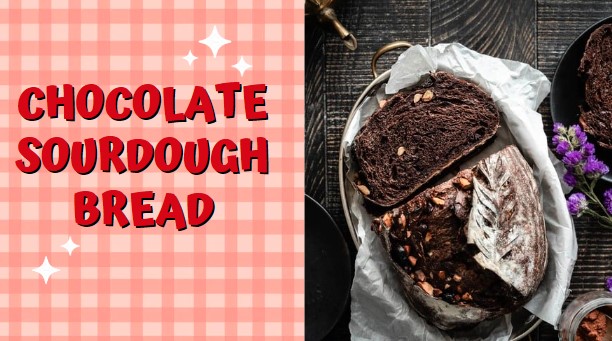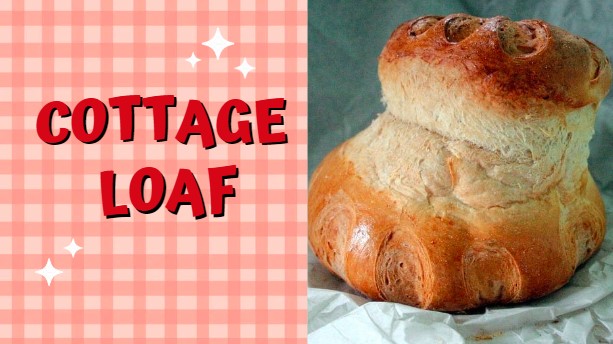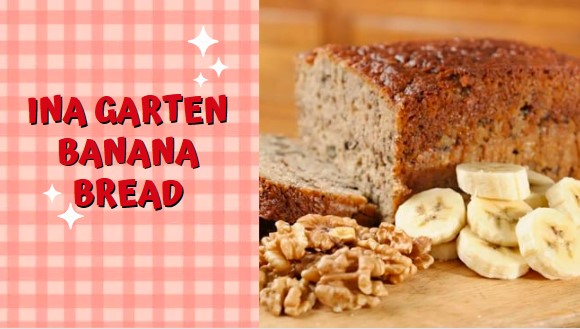Chocolate sourdough bread is a delightful twist on traditional sourdough loaves, infusing rich, decadent chocolate into the tangy, fermented dough. This bread combines the complexity of sourdough’s flavor with the indulgence of chocolate, making it a unique treat for both bread enthusiasts and chocolate lovers.
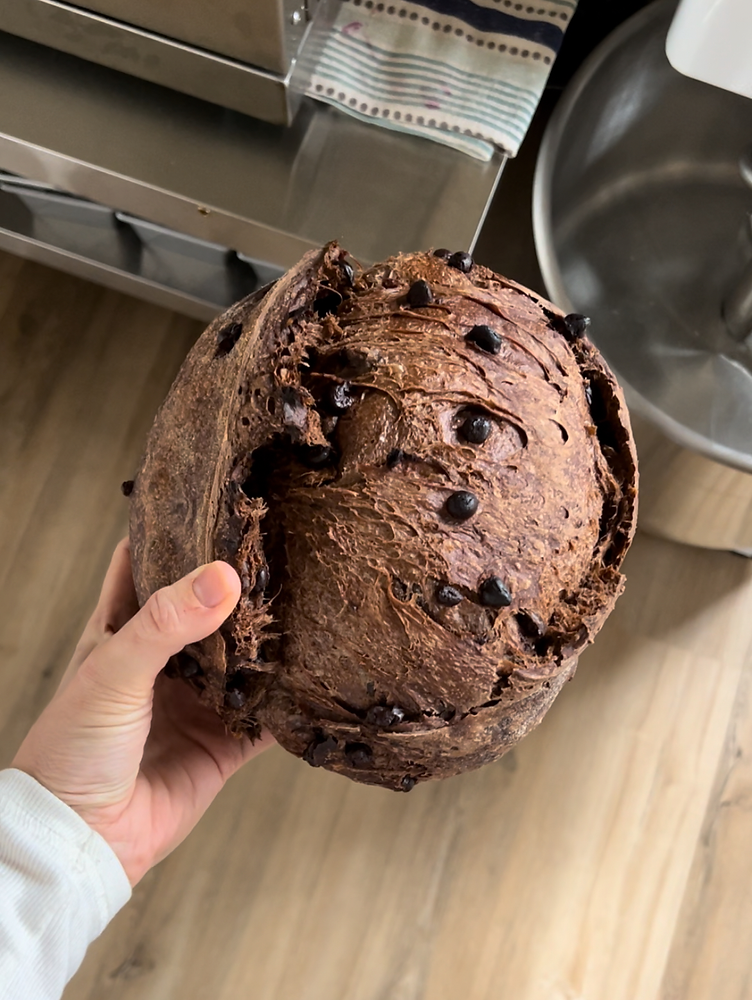
Creating chocolate sourdough bread involves adding cocoa powder and chocolate chips to the basic sourdough mixture. The cocoa powder enhances the dough with a deep, dark chocolate essence, while the chocolate chips provide sweet, melty pockets in the finished loaf. The result is a beautiful marbled bread that looks as stunning as it tastes.
The process starts with a well-developed sourdough starter—crucial for achieving the bread’s characteristic chewy texture and slightly sour taste. As the dough undergoes its long, slow fermentation, the flavors meld beautifully, with the tangy notes of the sourdough balancing the richness of the chocolate. Ideal for breakfast, a luxurious snack, or even as a base for extraordinary French toast, chocolate sourdough bread is a sophisticated upgrade to any baking repertoire, offering a perfect blend of flavor, texture, and aroma.
What Type Of Chocolate To Use In Chocolate Sourdough Bread?
Cocoa Powder: Using unsweetened cocoa powder is the most common choice for achieving a deep, rich chocolate base without adding extra sweetness. It integrates smoothly into the dough, offering a consistent chocolate flavor throughout the bread.
Chocolate Chips: For pockets of melty chocolate in your bread, semi-sweet or dark chocolate chips are ideal. They maintain their shape during baking but soften to create gooey, delicious bites. Choose high-quality chips for the best melting properties and flavor.
Chopped Chocolate Bars: If you want irregular chocolate chunks that melt variably within the bread, chopping up a bar of good-quality dark chocolate is a great option. This can give your loaf an artisanal feel with varied textures and intense chocolate bursts.
Cacao Nibs: For a more subtle, textured addition, cacao nibs can be sprinkled into the dough. These offer a nutty, slightly bitter crunch that contrasts nicely with the sourdough’s tanginess and the dough’s inherent sweetness.

Kitchen Tools Needed
Ingredients for Chocolate Sourdough Bread
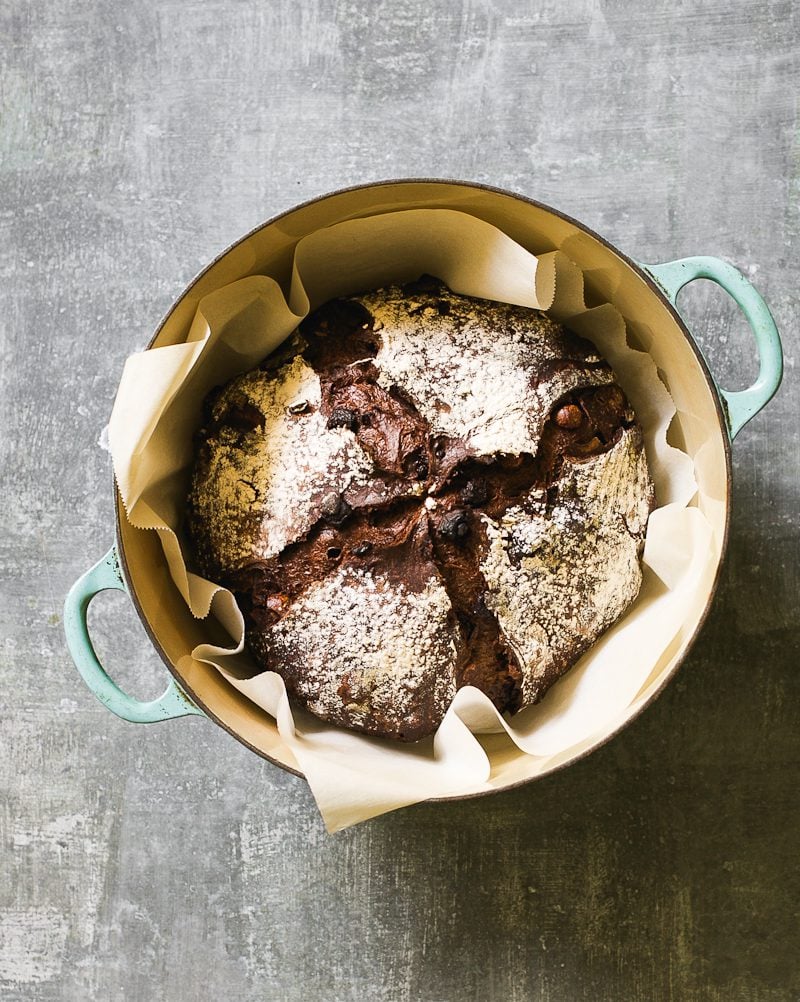
How To Make Chocolate Sourdough Bread?
Preparing the Sourdough Starter
Begin by ensuring your sourdough starter is active and bubbly. If it’s been stored in the refrigerator, feed it with equal parts flour and water and let it sit at room temperature for about 8-12 hours or until it doubles in size.
Mixing the Dough
In a large mixing bowl, combine the lukewarm water and sourdough starter, stirring until well blended. Add the all-purpose flour, cocoa powder, sugar, and salt to the bowl. Mix these ingredients until they start to form a rough dough. Let the mixture sit for about 30 minutes for the flour to hydrate, which helps with gluten development.
Kneading the Dough
After the dough has rested, add the softened butter. Knead the dough in the bowl or on a clean surface for about 10 minutes or until it becomes smooth and slightly elastic. Halfway through kneading, incorporate the chocolate chips or chopped chocolate, and continue kneading to distribute them evenly throughout the dough.
First Rise
Shape the dough into a ball and place it in a lightly greased bowl. Cover the bowl with a damp cloth or plastic wrap and let the dough rise at room temperature. This should take about 4 to 6 hours, depending on the warmth of your kitchen. The dough should approximately double in size.
Shaping the Bread
Once the dough has doubled, turn it out onto a lightly floured surface. Gently deflate the dough and shape it into a loaf or round, depending on your baking preference. If using a loaf pan, line it with parchment paper and lightly grease it with butter.
Second Rise
Place the shaped dough into the prepared loaf pan or on a parchment-lined baking tray if making a round loaf. Cover the dough loosely with greased plastic wrap and let it rise for another 2 to 4 hours until it puffs up noticeably.
Baking the Bread
Preheat your oven to 375 degrees Fahrenheit (190 degrees Celsius). If using a Dutch oven or baking stone, place it in the oven during preheating. Once the dough is ready and the oven is hot, uncover the dough and place it in the oven. If using a Dutch oven, carefully transfer the dough with the parchment paper into it and cover with the lid.
Bake for 25 minutes with the lid on, then remove the lid and continue baking for another 20-25 minutes, or until the bread has a firm crust and sounds hollow when tapped on the bottom. If baking in a loaf pan or on a tray, just bake uncovered for about 40-45 minutes.
Cooling
Remove the bread from the oven and let it cool on a wire rack for at least an hour before slicing. This resting period allows the steam to escape and the texture of the bread to stabilize, making it easier to slice.
Serving
Enjoy your chocolate sourdough bread as is, or toast slices and serve with a spread of butter or a drizzle of honey for added sweetness. This bread pairs beautifully with coffee or a glass of milk.
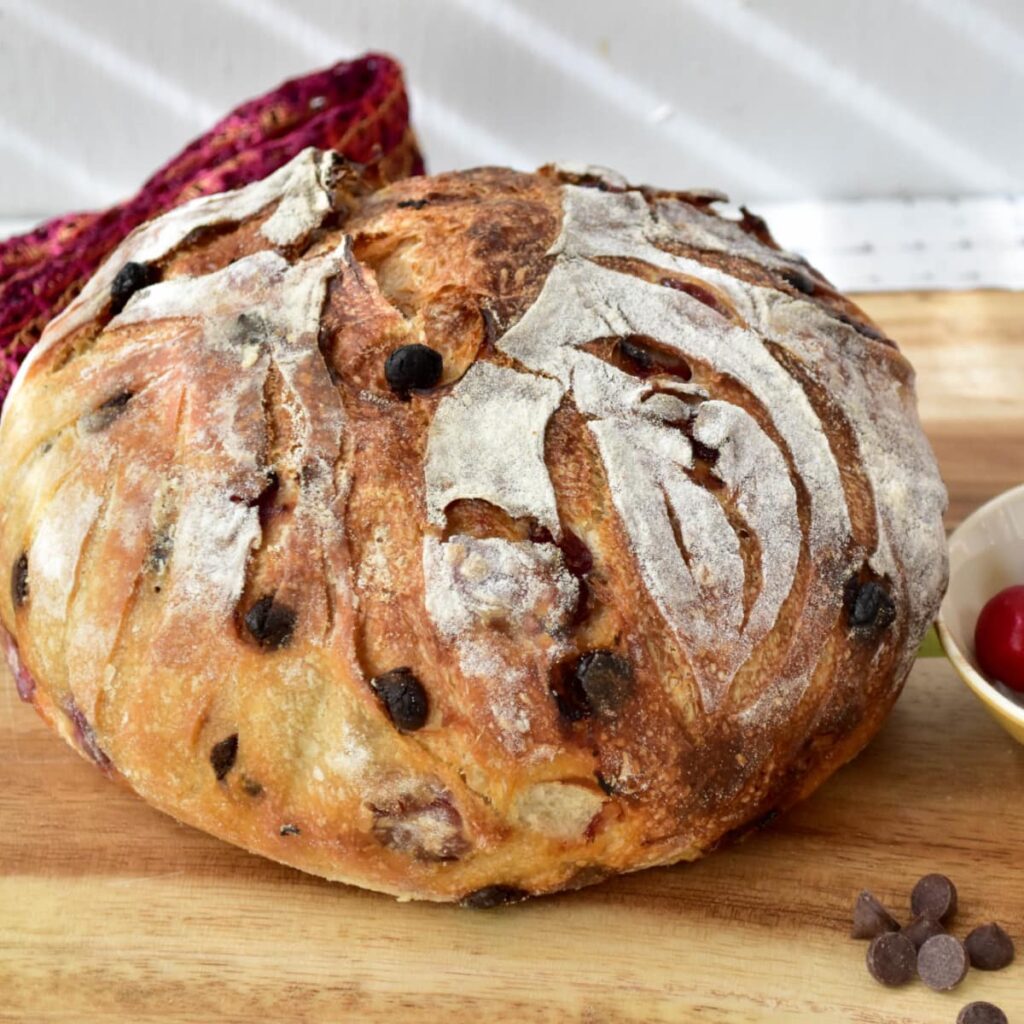
What to serve with chocolate sourdough bread ?
Health Benefits
Fermented Goodness: Like all sourdough breads, chocolate sourdough involves a fermentation process that can help improve digestive health. The natural fermentation helps to break down gluten, making it easier to digest and potentially lessening gluten sensitivity for some individuals.
Antioxidants: The cocoa used in chocolate sourdough bread is rich in antioxidants, specifically flavonoids, which are known to help reduce inflammation and improve heart health by lowering blood pressure and improving blood flow to the brain and heart.
Improved Nutrient Profile: The fermentation process not only makes the bread easier on the stomach but also increases the availability of key nutrients. Fermented foods are known to enhance the bioavailability of minerals, such as iron, zinc, and magnesium, which are crucial for overall health.
Mood Enhancing: Chocolate is well-known for its ability to boost mood, thanks to its cocoa content, which stimulates the brain to release endorphins, the body’s natural feel-good chemicals. Enjoying a slice of chocolate sourdough can provide a small boost to your mood.
Satiety and Weight Management: Thanks to its rich fiber content from both the sourdough and the added cocoa, chocolate sourdough bread can help you feel full longer. This can aid in weight management by reducing the temptation to snack excessively between meals.
Energy Supply: The combination of complex carbohydrates from the bread and the small amount of natural sugars from the chocolate provides a sustained source of energy, making it an excellent option for breakfast or as a pre-exercise snack.
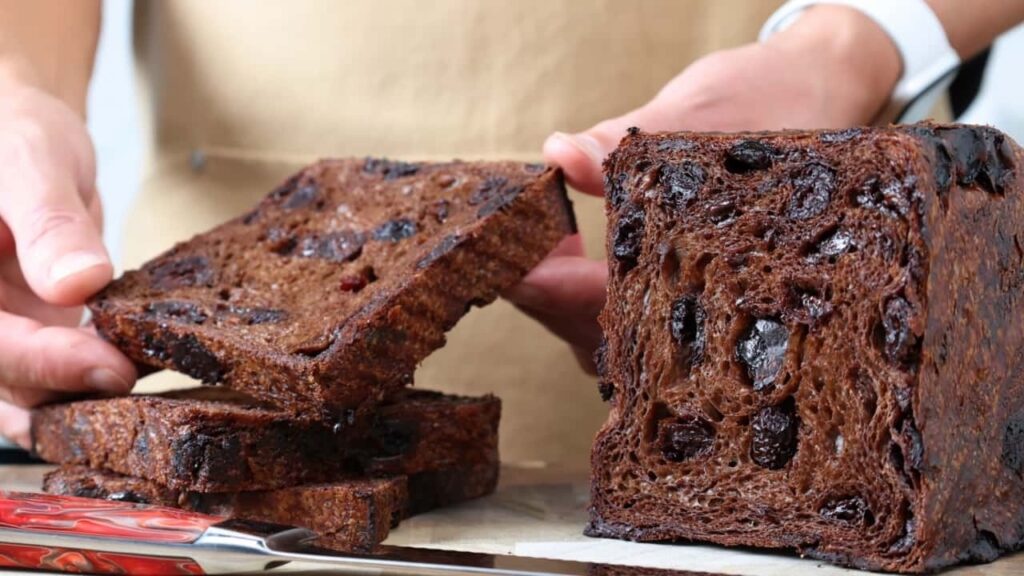
Tips And Tricks
Maintain a Healthy Starter: For the best results, ensure your sourdough starter is active and bubbly before you begin. Feed it regularly and keep it at a consistent temperature.
Control the Cocoa: When adding cocoa powder, sift it to avoid clumps and ensure it’s evenly distributed throughout the dough. This will give your bread a smooth, consistent chocolate flavor.
Hydration Matters: Chocolate sourdough dough can be a bit stiffer due to the absorbing nature of cocoa powder. Adjust the water quantity if your dough feels too tight or dry.
Incorporate Chocolate Thoughtfully: Add chocolate chips or chunks during the last few minutes of kneading to prevent them from breaking down too much. This keeps the bursts of chocolate intact.
Proof Patiently: Chocolate sourdough might require a longer proofing time due to the added ingredients. Be patient and let the dough rise until it’s visibly expanded and feels light to the touch.
Temperature Check: Use an oven thermometer to ensure your oven reaches the correct baking temperature. Inaccurate oven temperatures can lead to underbaked or overbaked bread.
Steam for the Crust: To achieve a crispy crust on your chocolate sourdough, introduce steam during the first few minutes of baking. You can do this by placing a pan of water on the lower rack of your oven.
Cool Completely: Allow the bread to cool on a wire rack for at least an hour before slicing. Cutting into it too soon can result in a gummy texture.
Storage Solutions: Wrap leftover chocolate sourdough bread tightly in plastic wrap or store it in an airtight container to maintain its freshness. It can also be sliced and frozen for long-term storage.
Experiment with Flavors: Feel free to add nuts, dried fruit, or a pinch of cinnamon or espresso powder to the dough for an extra flavor dimension that complements the chocolate.
Variations
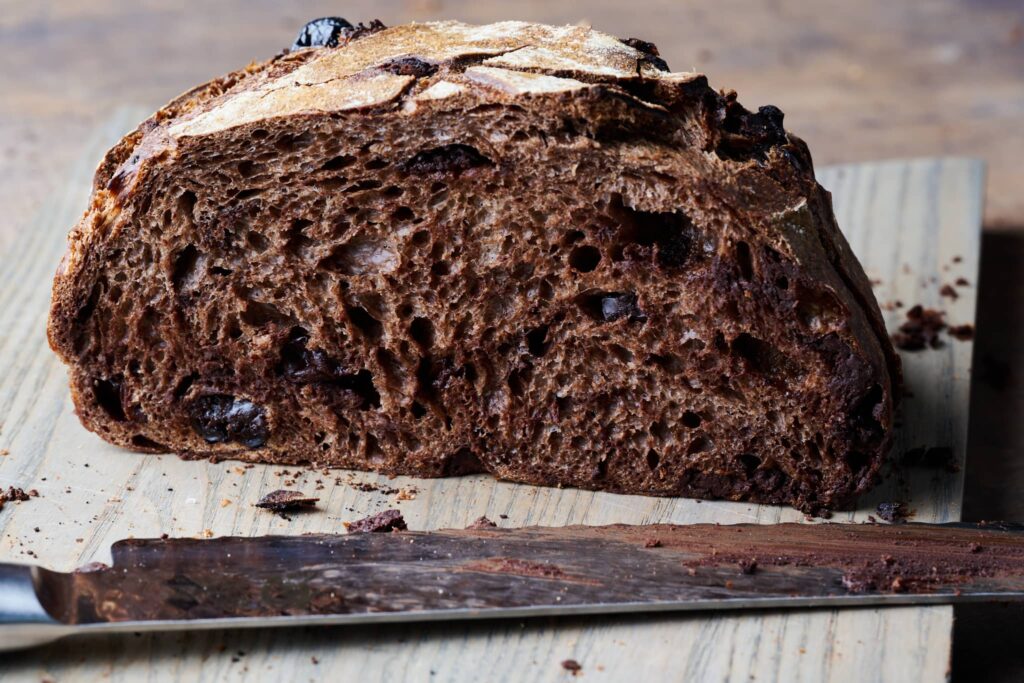
Substitutions
Making Ahead
Storage
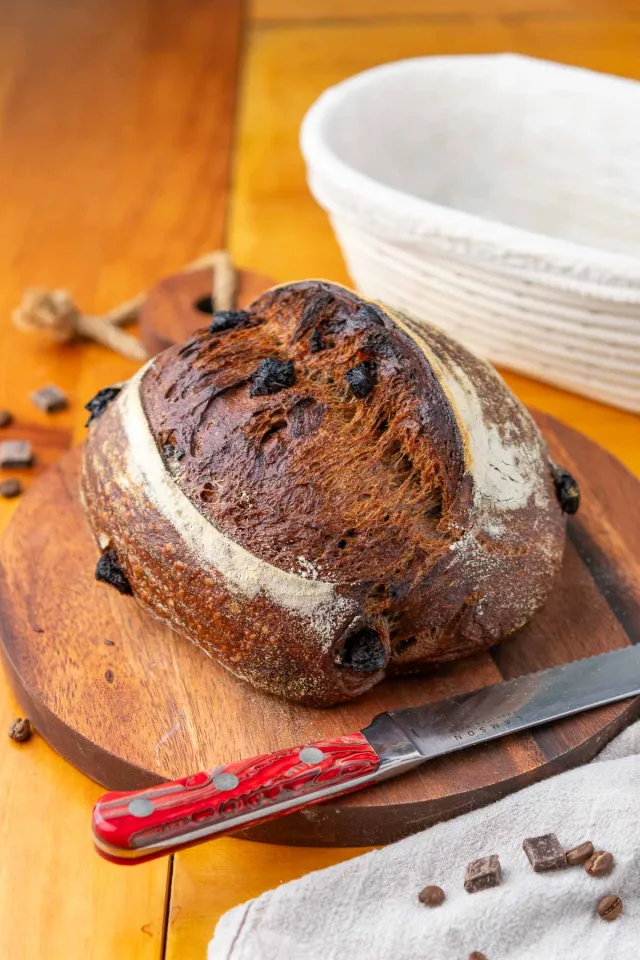
Reheating
Nutritional Facts
Key Nutritional Highlights
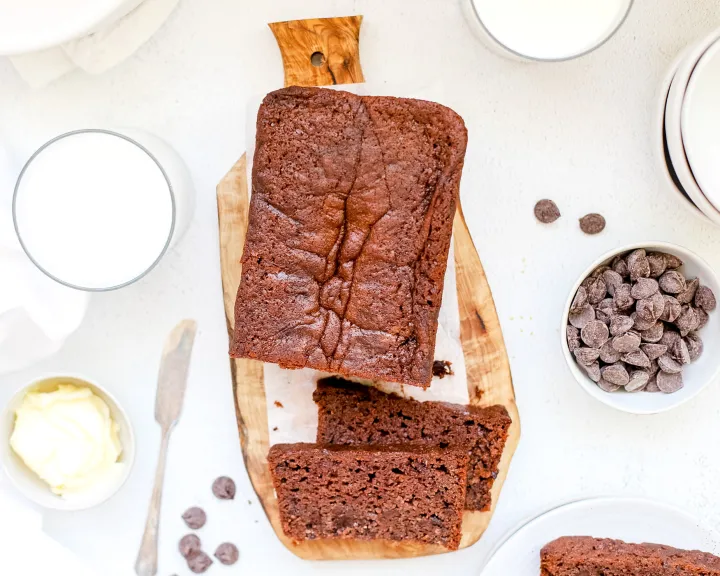
Tasty Breakfast Ideas
Super Easy Stuffed French Toast Recipe In Just 35 Minutes For Yummy Breakfast
Perfect Ina Garten Banana Bread Recipe
Frequently Asked Questions – FAQ’s
Chocolate Sourdough Bread
Course: BreakfastCuisine: AmericanDifficulty: Easy4
servings45
minutes160
kcalIngredients
Sourdough Starter: 100 grams (active and bubbly)
Water: 240 ml (lukewarm)
All-Purpose Flour: 350 grams
Cocoa Powder: 30 grams (unsweetened)
Sugar: 25 grams (to balance the cocoa’s bitterness)
Salt: 1 teaspoon
Chocolate Chips or Chopped Chocolate: 100 grams (dark or semi-sweet)
Butter: 30 grams (softened, for enriching the dough and greasing the pan)
Optional Add-ins:
Vanilla Extract: 1 teaspoon (for added flavor)
Cinnamon: 1/2 teaspoon (for a hint of spice)
Directions
- Begin by ensuring your sourdough starter is active and bubbly. If it’s been stored in the refrigerator, feed it with equal parts flour and water and let it sit at room temperature for about 8-12 hours or until it doubles in size.
- In a large mixing bowl, combine the lukewarm water and sourdough starter, stirring until well blended. Add the all-purpose flour, cocoa powder, sugar, and salt to the bowl. Mix these ingredients until they start to form a rough dough. Let the mixture sit for about 30 minutes for the flour to hydrate, which helps with gluten development.
- After the dough has rested, add the softened butter. Knead the dough in the bowl or on a clean surface for about 10 minutes or until it becomes smooth and slightly elastic. Halfway through kneading, incorporate the chocolate chips or chopped chocolate, and continue kneading to distribute them evenly throughout the dough.
- Shape the dough into a ball and place it in a lightly greased bowl. Cover the bowl with a damp cloth or plastic wrap and let the dough rise at room temperature. This should take about 4 to 6 hours, depending on the warmth of your kitchen. The dough should approximately double in size.
- Once the dough has doubled, turn it out onto a lightly floured surface. Gently deflate the dough and shape it into a loaf or round, depending on your baking preference. If using a loaf pan, line it with parchment paper and lightly grease it with butter.
- Place the shaped dough into the prepared loaf pan or on a parchment-lined baking tray if making a round loaf. Cover the dough loosely with greased plastic wrap and let it rise for another 2 to 4 hours until it puffs up noticeably.
- Preheat your oven to 375 degrees Fahrenheit (190 degrees Celsius). If using a Dutch oven or baking stone, place it in the oven during preheating. Once the dough is ready and the oven is hot, uncover the dough and place it in the oven. If using a Dutch oven, carefully transfer the dough with the parchment paper into it and cover with the lid.
- Bake for 25 minutes with the lid on, then remove the lid and continue baking for another 20-25 minutes, or until the bread has a firm crust and sounds hollow when tapped on the bottom. If baking in a loaf pan or on a tray, just bake uncovered for about 40-45 minutes.
- Remove the bread from the oven and let it cool on a wire rack for at least an hour before slicing. This resting period allows the steam to escape and the texture of the bread to stabilize, making it easier to slice.
- Enjoy your chocolate sourdough bread as is, or toast slices and serve with a spread of butter or a drizzle of honey for added sweetness. This bread pairs beautifully with coffee or a glass of milk.
Conclusion
Chocolate sourdough bread masterfully blends the rich flavors of chocolate with the classic tang of sourdough, creating a unique culinary experience. This bread is not just a treat for the taste buds but also brings the health benefits of fermented sourdough, including easier digestibility and enhanced nutrient absorption.
The versatility of chocolate sourdough bread allows it to be enjoyed in various ways, from a comforting morning toast to a decadent base for desserts. Whether you’re a chocolate lover, a sourdough enthusiast, or someone looking to expand their baking repertoire, chocolate sourdough bread offers a delightful and satisfying adventure.

